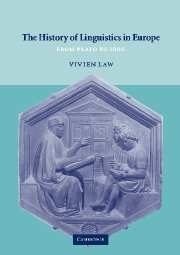Book contents
- Frontmatter
- Dedication
- Contents
- List of illustrations
- List of maps
- List of boxes
- Preface
- 1 Getting ready to study the history of linguistics
- 2 Greek philosophy and the origins of western linguistics
- 3 Towards a discipline of grammar: the transition from philosophy
- 4 From literacy to grammar: describing language structure in the ancient world
- 5 Christianity and language
- 6 The early Middle Ages
- 7 The Carolingian Renaissance
- 8 Scholasticism: linking language and reality
- 9 Medieval vernacular grammars
- 10 The Renaissance: discovery of the outer world
- 11 A brief overview of linguistics since 1600
- 12 Becoming a historian of linguistics
- Research resources in the history of linguistics
- Notes
- Index
4 - From literacy to grammar: describing language structure in the ancient world
Published online by Cambridge University Press: 05 March 2015
- Frontmatter
- Dedication
- Contents
- List of illustrations
- List of maps
- List of boxes
- Preface
- 1 Getting ready to study the history of linguistics
- 2 Greek philosophy and the origins of western linguistics
- 3 Towards a discipline of grammar: the transition from philosophy
- 4 From literacy to grammar: describing language structure in the ancient world
- 5 Christianity and language
- 6 The early Middle Ages
- 7 The Carolingian Renaissance
- 8 Scholasticism: linking language and reality
- 9 Medieval vernacular grammars
- 10 The Renaissance: discovery of the outer world
- 11 A brief overview of linguistics since 1600
- 12 Becoming a historian of linguistics
- Research resources in the history of linguistics
- Notes
- Index
Summary
From literacy to grammar
In the Cratylus Socrates refers to ‘those who are skilled in vowels and consonants’, and Aristotle mentions grammarians (grammatikoi). In any literate society there are teachers whose job it is to impart the basic skills of reading, writing and numeracy. In ancient Greece the origins of the profession are encoded in the name: grammatikos (the singular of grammatikoi) is visibly derived from gramma ‘letter’ (plural grammata). Of course, one can teach someone to read without any grammatical concepts more sophisticated than ‘letter’, ‘sound’ and ‘word’: equivalent terms are found in all literate societies, and in most, if not all, preliterate societies. In other words, the ability to read and write – and by implication to devise a writing system – does not presuppose an extensive repertoire of linguistic concepts, still less a well-developed system of grammar or theoretical linguistics. What is it that gives the impetus to move on to that stage? In ancient India the desire to preserve an older, more ‘correct’ form of pronunciation was the spur for the description of the articulatory phonetics of Sanskrit; in the medieval Arab world the need of foreign converts to Islam for instruction in Arabic, the language of the Qur'an, together with a feeling of nostalgia for the ancient language of the Beduin, lay behind the first grammars; but in the Greek world the motivation for the writing of grammars is less clear.
- Type
- Chapter
- Information
- The History of Linguistics in EuropeFrom Plato to 1600, pp. 52 - 93Publisher: Cambridge University PressPrint publication year: 2003

